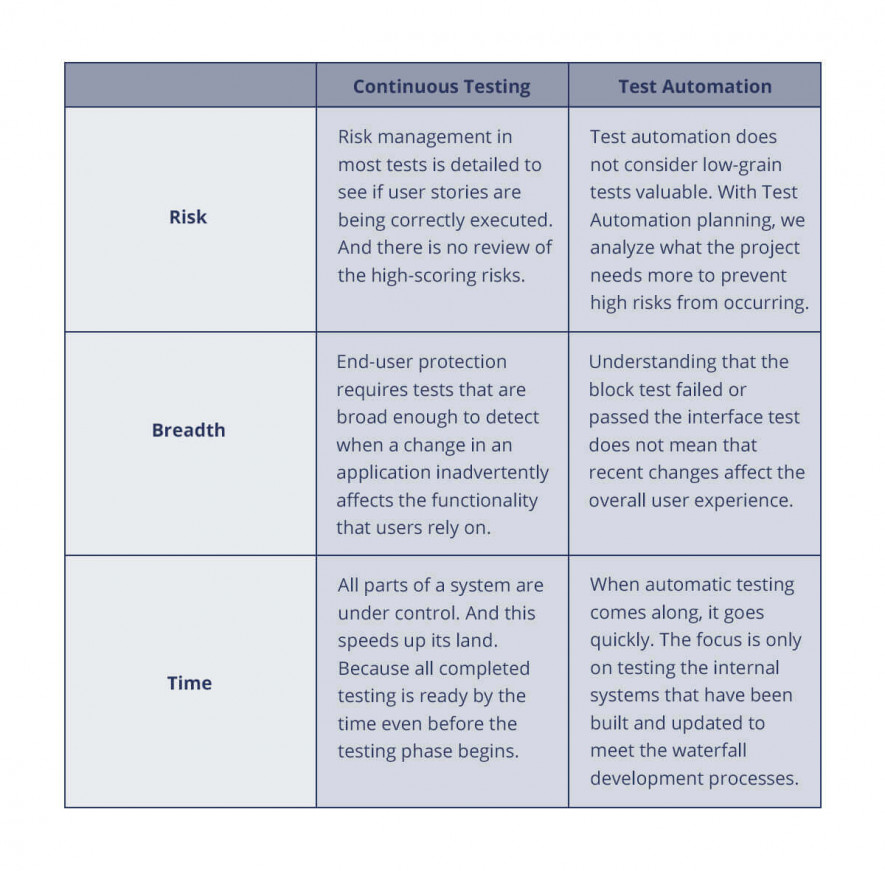Continuous Testing and Test Automation: What is the Difference?
by Viktoria Byk | November 14, 2019 8:03 pm
If you have 100% knowledge of the nuances and diversity of the сontinuous testing and test automation, you can leave this page and read something else. Here we will not reinvent the wheel. This article contrasts these two techniques along with their main principles and differences. It also tells how and why combining these testing types is one of the greatest ways out there.
Basic principles of Continuous Testing
Continuous performance testing is one of the testing types to do software testing that presupposes early-stage testing: process, frequently and everywhere testing, with automation. In terms of continuous testing strategy, this applies to any steps that work for software delivery.
The main part during continuous testing is the transformation of the central question during work on a project:
When are we going to be done with testing?
into
Did the release team consider every business risk revealed during testing?

Continuous testing includes the process of automated testing within a software delivery pipeline. Among the basic principles of сontinuous testing there are:
- The inability of last-minute decisions. Testing cannot be put to action late: there is a need for accurate estimates.
- High Maintenance. Testers need to constantly solve the aroused challenges rather than perform as many tests as possible for quick release.
- Low Execution Time. There’s an importance for tests to be more than on time but also leave time to analyze detected errors along with the effect on the user experience.
- Instability of the Test Environment. The process of testing might be suspended if you do not have to rely on the already provided product (result). It can affect entire subsequent cases, like DevOps and Agile methodologies say.
Main differences between Continuous Testing and Test Automation
QATestLab divided the major differences between Continuous Testing and Test Automation:

- We considered the main differences and to understand this subject of testing better, here are its aspects:
- testing is among the central parts of a development process;
- fresh feature in your product = test running;
- process of testing should be organized by stages: starting from the system level and end-to-end testing at it, then, after integration, API as a substitute message layer testing and so on;
- the testing environment should be stable. It is required to ensure that frequent changes do not cause an overwhelming number of false positives.
How to combine various testing practices
Every company got its own way of doing business. Nevertheless, there do exist tips and rules. Take the best that is in these processes and combine them. Because without Continuous Testing, the Test Automation system is weak in such points as:
- There are no real capabilities that implement tests quickly or often.
- The continuous change applies to more false positives and requires endless use of test services.
- There is no accurate and fast prediction if the project is a candidate for delivery.
And don’t forget about the basic principle of optimizing testing as a whole:
- Started from the button, now we are here. Start with a general practice. It is best to start with general testing methods. After all, if everyone else has tried these practices, they can be good evidence that these tests are truly valid for all types of organizations.
- Yin and Yang. Both common practices, positive testing as negative testing will be critical components for improving the project’s quality with ensuring optimal program performance.
- Apps could be compared with snowflakes – each of them is unique. Dive into the specifics. Once you include general tests – it is time to conduct specific ones.
- The user’s requests orientation. Surfing of statistics as well as progress should be common best practices for testing for your team. You actually could use the software testing metrics[1] based on the specific needs of the users.
Conclusions
Combining practices is great. Especially it’s true for software development since applications can serve many different requirements. Quality control teams should listen to user requirements along with using both generals, and as a specific company approaches to make up the best practices for software testing for their projects.
However, to sum up, our advice in this article of our blog:

Quality Assurance engineers had great achievements when they used traditional tools of automation. They have to try to use modern delivery methods and architectures with a little note:
- It’s better to take care of business risks when releasing an app than just put as many as you can autotests, which are not helpful with bugs on their own.
- QA team[2] doesn’t need to deploy and use any tests in a hurry.
- Permanent revision is useful in reducing wrong inquiries that could be the reason for the endless existence of test services.
QATestLab recommends searching together with keeping the trends of continuous testing and test automation on your screens if you want to optimize testing.
Learn more from QATestLab
Related Posts:
- software testing metrics: https://blog.qatestlab.com/2019/09/12/top-testing-metrics/
- QA team: https://blog.qatestlab.com/2019/05/07/building-qa-team/
- Test Automation: Cleaning Up Your Test Scripts: https://blog.qatestlab.com/2016/06/30/automated-test-scripts/
- The Power of Automated QA in E-Commerce: Speed, Stability, and Success : https://blog.qatestlab.com/2025/10/16/the-power-of-automated-qa-for-e-commerce-speed-stability-and-success/
- Beyond Hours: Why Forward-Thinking Companies Choose Outcome-Based QA : https://blog.qatestlab.com/2025/08/21/beyond-hours-why-forward-thinking-companies-choose-outcome-based-qa/
Source URL: https://blog.qatestlab.com/2019/11/14/continuous-vs-automation/

